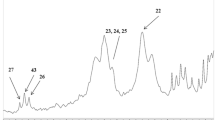Abstract
This study aimed at determination of the effect caused by ingestion of beetroot juice fermented by Lactobacillus casei 0920 and Lactobacillus brevis 0944 strains on the state of cecal ecosystem of experimental rats. The intake of fermented beetroot juice containing 3.5–4.0 × 109 CFU/mL live Lactobacillus sp. cells positively modulated the cecal microflora of the rats and its metabolic activity. The counts of Lactobacillus sp., Bifidobacterium sp., Bacteriodes sp., and Enterococcus sp. were maintained at the level of 8.2–8.6, 6.2–7.5, 8.0–8.3, and 7.3–7.7 log units, respectively, while the number of Clostridium sp. cells was increased by 1.1–1.6 log units and Enterobacteriaceae bacteria were reduced by 0.8–2.1 log units. In this study, the selected cecal enzymes such as β-glucosidase, β-glucuronidase, and β-galactosidase as well as the profile and concentration of short chain fatty acids (SCFA) were the biochemical markers of metabolic activity of the intestinal ecosystem. The considerable decrease in activities of β-glucosidase and β-glucuronidase was observed in all three experimental groups fed with the fermented beetroot juice. Total concentration of SCFA was the highest (78.1 μmol/100 g BW vs. 59.2 μmol/100 g BW in control group) in intestines of rats fed with 6 mL of fermented beetroot juice daily. These results prove that the fermented beetroot juice benefits cecal microbial activity.
Similar content being viewed by others
References
Urala N, Lähteenmäki L (2007) Food Qual Prefer 18:1–12
Stintzing FC, Carle R (2004) Trends Food Sci Technol 15:19–39
Kapadia GJ, Azuine MA, Sridhar R, Okuda Y, Tsuruta A, Ichiishi E, Mukainake T, Takasaki M, Konoshima T, Nishino H, Tokuda H (2003) Pharmacol Res 47:141–148
Haveland-Smith RB (1981) Mutation Res 91:285–289
Linanówka-Jagard D, Czapski J, Walkowiak-Tomczak D (1995) International conference of agro biotechnology, Poznan, 15–20 Sept, p S127
Motyl I (2002) Ph.D. thesis, Technical University of Lodz, Poland
Czyżowska A, Klewicka E, Libudzisz Z (2006) Eur Food Res Technol 223:110–116
Reeves PG (1997) J Nutr 127:S838–S841
Hartemink R, Kok BJ, Weenk GH, Rombouts FM (1996) J Microbiol Met 27:33–43
Juśkiewicz J, Zduńczyk Z, Wróblewska M, Oszmiański J, Hernandez T (2002) Food Res Int 35:201–205
Lowry OH, Rosebrough NJ, Farr A, Randal RJ (1951) J Biol Chem 193:265–275
Juśkiewicz J, Klewicki R, Zduńczyk Z (2006) Nutr Res 26:531–536
Czyżowska A, Klewicka E, Libudzisz Z (2006) 4th international congress on pigments in food a challenge to life sciences, Stuttgart, Hohenheim, 9–12 Oct, pp 250–252
Klewicka E, Motyl I, Libudzisz Z (2004) Przemysł Fermentacyjny i Owocowo-Warzywny 12:34–35 (in Polish)
Garrido D, Suwu A, Pochart P, Cruchet S, Gotteland M (2005) FEMS Microbiol Lett 248:249–256
Biagi G, Cipollini I, Pompei A, Zaghini G, Matteuzzi D (2007) Vet Microbiol 124:160–165
Alvaro E, Andrieux C, Rochet V, Rigottier-Gois L, Leprrcq P, Sutren M, Galan P, Duval Y, Juste C, Dore J (2007) Br J Nutr 97:126–133
Wollowski I, Rechkemmer G, Pool-Zobel BL (2001) Am J Nutr 73(suppl):451S–455S
Chadwick RJ, George E, Claxtron LD (1992) Drug Metab Rev 24:425–492
Martineau B, Laflamme DP (2002) Res Vet Sci 72:223–227
Lupton JR (2004) J Nutr 134:479–482
Olmo N, Turnay J, Perez-Ramos P, Lecona E, Barrasa JI, Lopez de Silanes I, Lizarbe MA (2007) Toxicol In Vitro 21:262–270
Author information
Authors and Affiliations
Corresponding author
Rights and permissions
About this article
Cite this article
Klewicka, E., Zduńczyk, Z. & Juśkiewicz, J. Effect of lactobacillus fermented beetroot juice on composition and activity of cecal microflora of rats. Eur Food Res Technol 229, 153–157 (2009). https://doi.org/10.1007/s00217-009-1036-x
Received:
Revised:
Accepted:
Published:
Issue Date:
DOI: https://doi.org/10.1007/s00217-009-1036-x




